Centro Storico is the most picturesque part of Rome.
It’s a tangle of cobbled alleyways, Renaissance and Baroque monuments, ancient ruins, and pretty piazzas. This is the historic Rome that so many visitors come to see.
My walking tour of central Rome starts at the Vittorio Emmanuel II Monument in Piazza Venezia and ends at Piazza del Popolo. You can easily reverse the order and start at the Piazza del Popolo, if that’s closer to where you’re staying.
This walking tour through central Rome includes stops at 20+ of the most famous places in Rome — the top attractions, monuments, palaces, and landmarks.
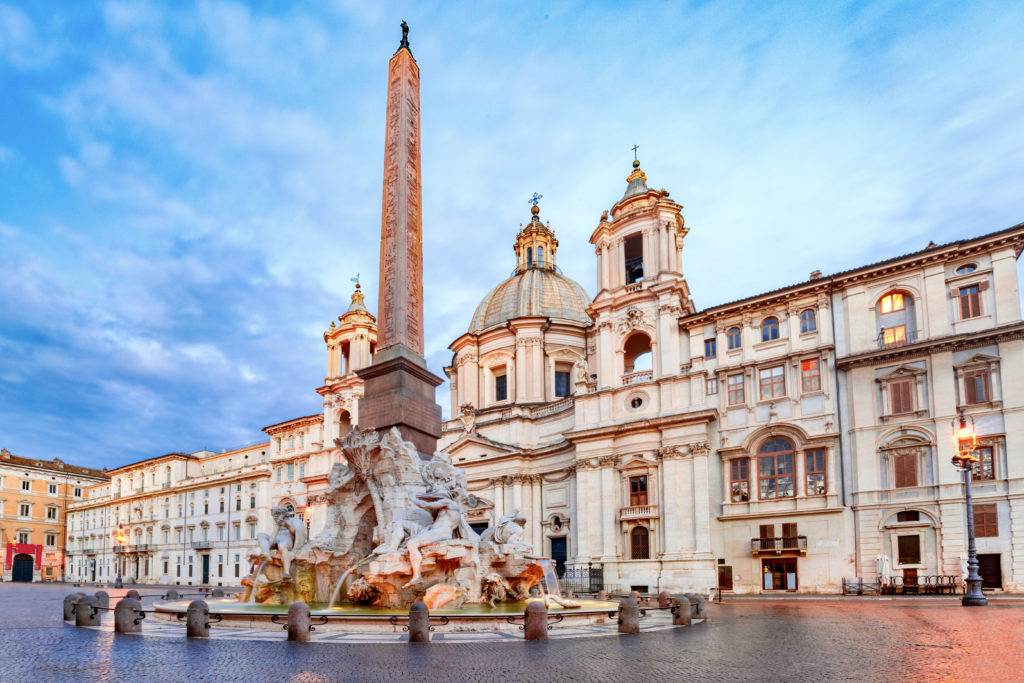
I’ve listed these destinations in the order you’ll encounter them on this walk, which involves a bit of zig zagging around to see everything in Central Rome. I’ve given you the addresses too, which you can put in your phone GPS.
Unlike other large European cities like Paris, Central Rome is compact. Most of the attractions are clumped together and easy to cover on foot.
I’ve listed the time it takes to walk between each attraction to help you plan, which is typically just a few minutes.
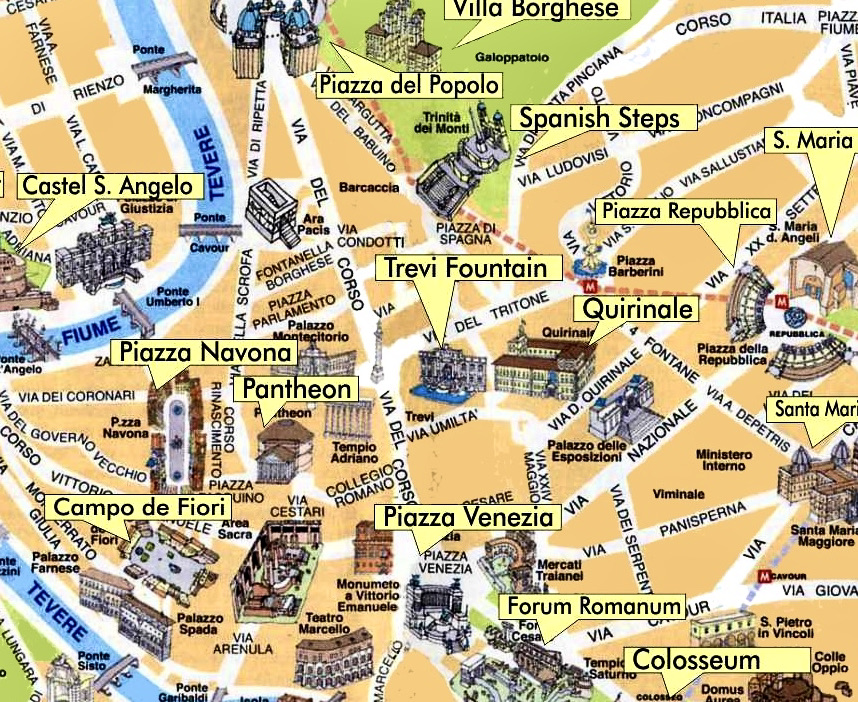
Visiting all the sites on this list thoroughly could easily take a few days in Rome, especially if you opt to go inside to explore. If you are just strolling, you can definitely see them all in one day.
This guide only covers Rome’s city center. It doesn’t cover the Imperial sites to the east or Vatican City to the west.
But, if you want to know more about those attractions, here are my guides to the Colosseum, the Roman Forum, Palatine Hill, and the Vatican Museums.
You can follow my itinerary for a DIY stroll. Or you can book a 3 hour guided walking tour or private walking tour of this beautiful part of Rome.
20+ Must Visit Attractions and Best Stops in Central Rome
1. Vittorio Emmanuel II Monument
Your day begins at the Vittorio Emmanuel II Monument located in Piazza Venezia, Rome’s central hub. It’s a breathtaking spot, with the white marble of the Vittoriano taking center stage.
Romans either love or hate the supersized monument. It’s nicknamed the “wedding cake” or “typewriter” monument.
The gleaming edifice was built to honor Italy’s first king. The 43 foot long statue of Vittorio in front is one of the world’s largest equestrian monuments.
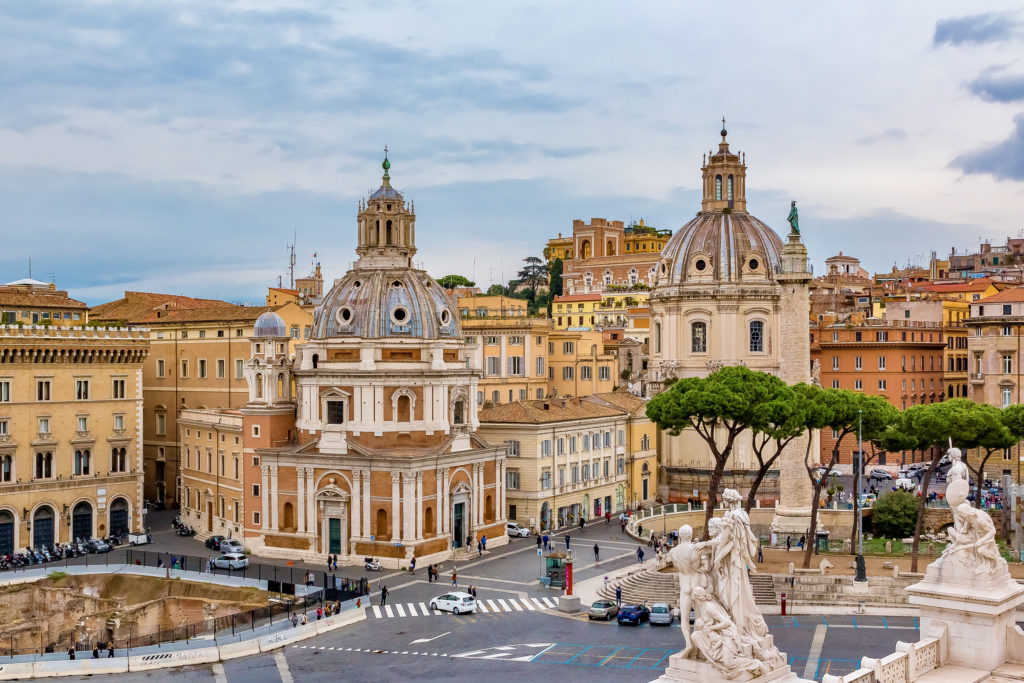
You can go up the steps and admire it for free. Inside, there are cafes and a museum, with views from the cafe terrace and other spots.
But what most people fail to do is go around back. There’s an elevator that takes you up to the tip top for some of the best views in Rome.
The elevator is expensive at 10 euros. But it’s completely worthwhile. From the terrace, you have stunning views of the Roman Forum, Via dei Fori Imperiali, Piazza del Popolo, and the dome of St. Peter’s.
>>> Click here to book a ticket for the glass elevator
2. Santa Maria in Ara Coeli
Time from the Vittoriano: 1 minute
Before you leave Piazza Venezia and head west, go around back to explore the Basilica of Santa Maria in Ara Coeli. It’s one of the most beautiful churches in Rome.
Ara Coeli means “altar of heaven.” The church is hidden behind an austere brick facade once covered with mosaics.
The original church dates from the 6th century. But the church you see today is from the 14th century. During the Middle Ages, the church was used as the meeting place for the Roman Senate.
Inside, there’s a large nave with 22 ancient granite columns separating the aisles. According to an inscription, one column came from the House of Augustus on Palatine Hill.
The church is mostly known for its beautiful frescos by Pinturicchio, an important early Renaissance artist. They’re located in the Chapel of Bernardino of Siena.
Pinturicchio completed the frescos in 1484. The frescos have grotesque motifs, inspired by ancient frescos that had just been discovered in Nero’s Golden House.
The church has a spectacular gilded wooden ceiling, dating from the 16th century. The ceiling commemorates the Christian Victory of Leptano over the muslims.
Other things to look for are the high altar with a Byzantine madonna icon, Bernini’s marble memorial to Pope Urban VIII, a tabernacle by the Florentine sculptor-architect Arnolfo di Cambio, and the tombstone of Donatello.
3. Palazzo Doria Pamphilj
Time from Santa Maria in Ara Coeli: 8 minutes
Then, head north just a few minutes to my personal favorite palace museum in Rome, the Palazzo Doria Pamphilj. The museum provides a near overdose art high.
The museums holds a princely collection of 17th century works, one of the most impressive private collections in Europe. The museum is one of Rome’s hidden gems.
It’s housed in a lavish Roman-Rococo palace. Every inch of the walls and ceilings are decorated with beautiful frescos, tapestries, and glittering chandeliers.
The art collection was meticulously assembled and is still owned by a powerful Italian family, the Doria Pamphilj (pronounced Pom-fee-lee). The museum boasts over 700 works spanning the 15th to 18th centuries. There are rare master works by Bernini, Caravaggio, Velazquez, Titian, Carracci, and Bruegel.
The Doria Pamphilj’s most famous painting is Velazquez’s Portrait of Pope Innocent X. He’s portrayed as a stern intimidating figure. The painting is housed in its own room behind glass.
The portrait was so individualized that the pope remarked “It is too true!” Nearby is Bernini’s marble bust of the same pope.
Of special note are two rare Caravaggio paintings, the Penitent Magdelene and the beautiful The Rest on the Flight Into Egypt. They’re on display in the splendid Aldobrandini Room.
A Doria Pamphilj prince narrates the audio guide with amusing historical detail and insight. Click here to book an entrance ticket.
4. Largo di Torre Argentina
Time from Palazzo Doria Pamphilj: 8 minutes
After visiting the palazzo, head west to Largo di Torre Argentina. It’s another must visit attraction in central Rome, especially for history buffs. This is the site of Julius Caesar’s assassination on the Ides of March in 44 B.C.
Caesar was assassinated by a conspiracy of senators under the guise of “liberty.” They feared Caesar would crown himself king. The assassination was one of the most pivotal moments of the Roman Republic.
What the assassins didn’t predict is that Caesar’s death would make him a martyr. It incited civil wars that led to the downfall of the republic and the rise of the Roman Empire.
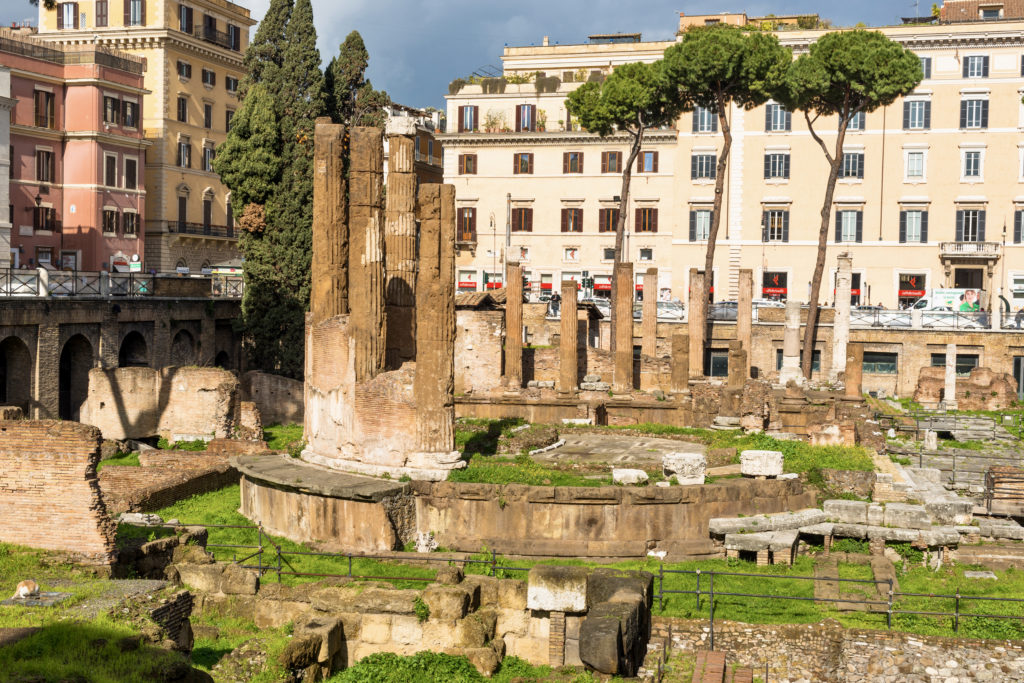
Previously, the ruins of the Largo could only be admired from a street level viewing platform. In June 2023, the site opened to the public. You can now go down and admire the ruins close up from walkways.
You can visit four Republican era pagan temples and the ruins of the Theater of Pompey. The theater was built in 55 B.C. by the great military general Pompey the Great.
The curia (meeting house) of the theater was where the Roman senators met after they had outgrown the senate house in the Roman Forum.
There’s also a fenced off feral Cat Sanctuary onsite. It’s protected and funded by an animal protection organization.
5. Campo de Fiori
Time from Largo Torre di Argentina: 4 minutes
Your next stop in central Rome is the Campo de Fiori. It’s Rome’s colorful and chaotic market square. Campo dei Fiori name means “field of flowers.”
In the market, you’ll find stalls with fresh produce. You can pick up some souvenirs like olive oil, pasta, or limoncello. You can book a 4 hour guided food tour that includes the market.
Piazza Campo de Fiori was also the place where heretics were once executed. In the center is a statue of Giordano Bruno.
He was a 16th century friar and philosopher who was burned at the stake for his radical scientific theories. In the 19th century, Bruno became a martyr in the cause of freedom of thought.
Tip: If you are in the area and hungry, Verso Sera is a great little trattoria.
>>> Click here to book an evening walking tour of the Campo de Fiori
6. Palazzo della Cancelleria
Time from Campo de Fiori: 1 minute
Right next to Campo de Fiori is the Palazzo Cancelleria. Built between 1485 and 1511, the palace was the first true Renaissance palace in Rome. It was one of the most influential architectural projects of the 15th century.
The palace combines elements of Renaissance architecture from Florence, Urbino, and Rome. Despite its historical significance, the palace’s architect is unknown.
In 1546, the Florentine artist Giorgio Vasari was commissioned to fresco the palace’s grand salon. The frescoes were commissioned by Cardinal Alessandro Farnese to celebrate the life of his grandfather Pope Paul III.
The frescos feature scenes from the life of the pope. The frescos are notable for their fictive architecture and complex iconography.
Vasari finished the frescos in 100 days. The salon was thereafter dubbed the “Hall of the Hundred Days.” Legend holds that Vasari bragged about the quick execution to his hero and fellow artist Michelangelo. Michelangleo tartly said “si vede” (“it shows”).
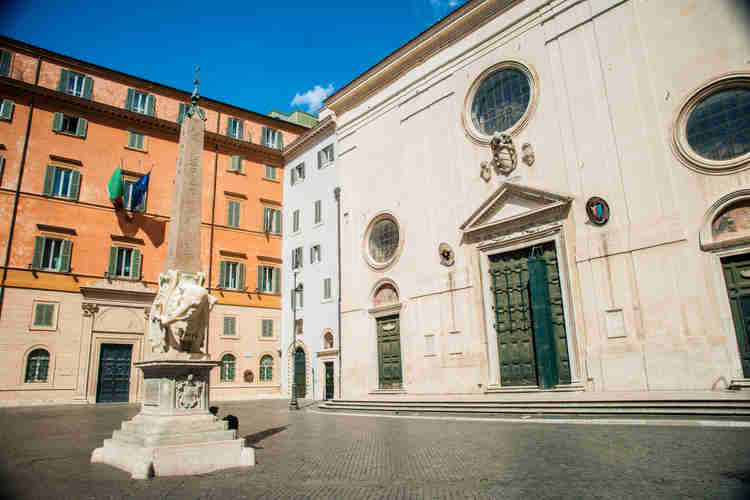
7. Santa Maria Sopra Minerva
Time from Palazzo Cancelleria: 2 minutes
The next attraction on your walking tour of central Rome is Santa Maria Sopra Minerva. Don’t let the basilica’s plain facade fool you. There are treasures aplenty inside. The Minerva is a mini-museum and hidden gem in Rome.
The Minerva is Rome’s only Gothic church. The basilica was founded in the 7th century and built over a Roman temple presumably dedicated to Minerva.
At the end of the 13th century, the Minerva was rebuilt in a Gothic style by a Dominican order. They added the classic blue-sky-with-gold-stars vaulted ceiling.
Inside, you’ll see frescos and sculptures by some of the greatest artists of the Renaissance and Baroque, including Michelangelo and Bernini. And a splendid collection of medieval and Renaissance tombs of famous saints, popes, artists, and influential figures.
The Carafa Chapel is the undisputed highlight of the Minerva. The chapel is famous for its magnificent 15th century frescos by Filippino Lippi, one of Sandro Botticelli’s best student.
The Carafa Chapel is dedicated to the Virgin Mary and Saint Thomas Aquinas. The most famous of Lippi’s scenes is the wall fresco, The Assumption of Our Lady, above the altarpiece.
The fresco depicts angels carrying Mary upward to heaven. Below The Assumption are the frescos of the life of the Dominican theologian Saint Thomas Aquinas.
>>> Click here to book a guided tour of the Sopra Minerva and the Pantheon
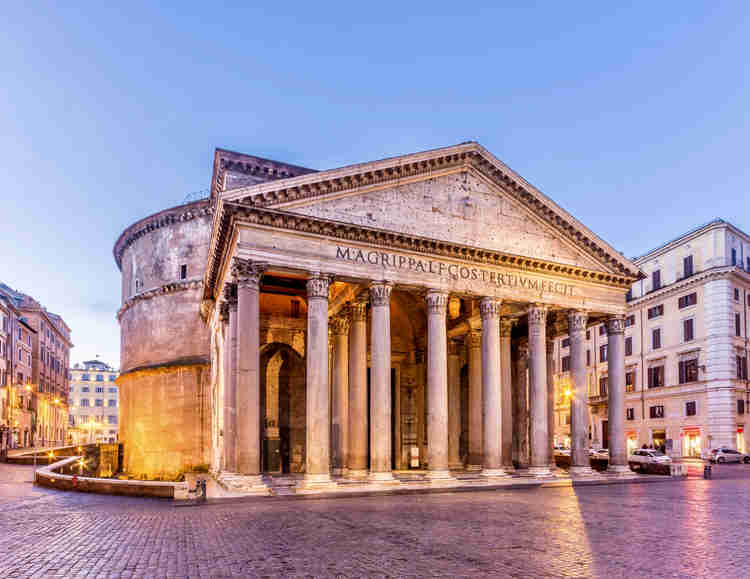
8. Pantheon
Time from Sopra Minerva: 1 minute
Next, you’ll visit one of the top sites in central Rome, with a real wow factor. Without a doubt, the Pantheon is the best preserved building from Ancient Rome.
The Pantheon was a temple dedicated to all of the gods. It was originally built by Augustus’ right hand man, Marcus Agrippa, in 27 BC. But Agrippa’s version was destroyed by fire.
In 120 AD, the Pantheon was rebuilt by Hadrian. The well-traveled emperor, a true Grecophile, reimagined it as an oversized Greek temple. He gave it 40 foot tall Corinthian granite columns from Egypt, a pediment, and portico. It was considered a masterpiece of engineering and mathematical precision.
The Pantheon’s most emblematic feature is its perfect unsupported spherical dome. At the time, it was a major architectural breakthrough.
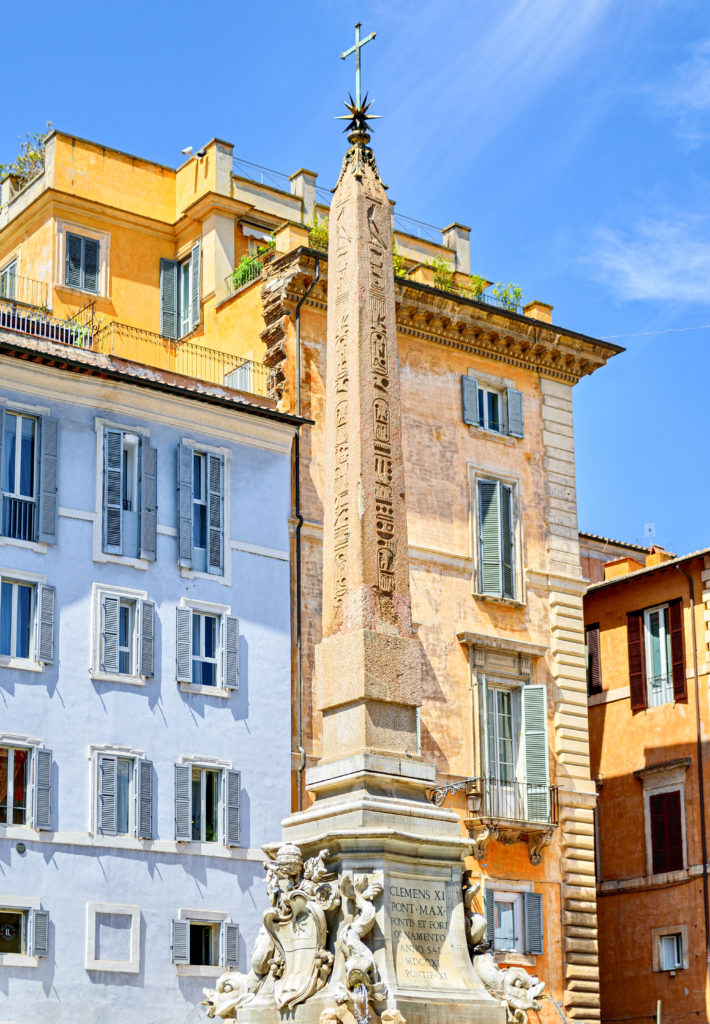
The dome became the model for Michelangelo’s dome for St. Peter’s Basilica and for Brunelleschi’s dome for Florence Cathedral. At the top is an oculus, or eye, which is the Pantheon’s only source of natural light.
After the fall of Rome, the Pantheon became a Christian church, which helped save it from looting at first. But eventually the interior, marble, and gold were all looted in the 7th century, although the marble floor is now lovingly recreated.
The Pantheon is filled with tombs of important Romans, including the famed Renaissance artist Raphael.
The Pantheon used to be free to visit. But as of July 3, 2023 there is a 5 euro fee. Click here to book a ticket in advance.e
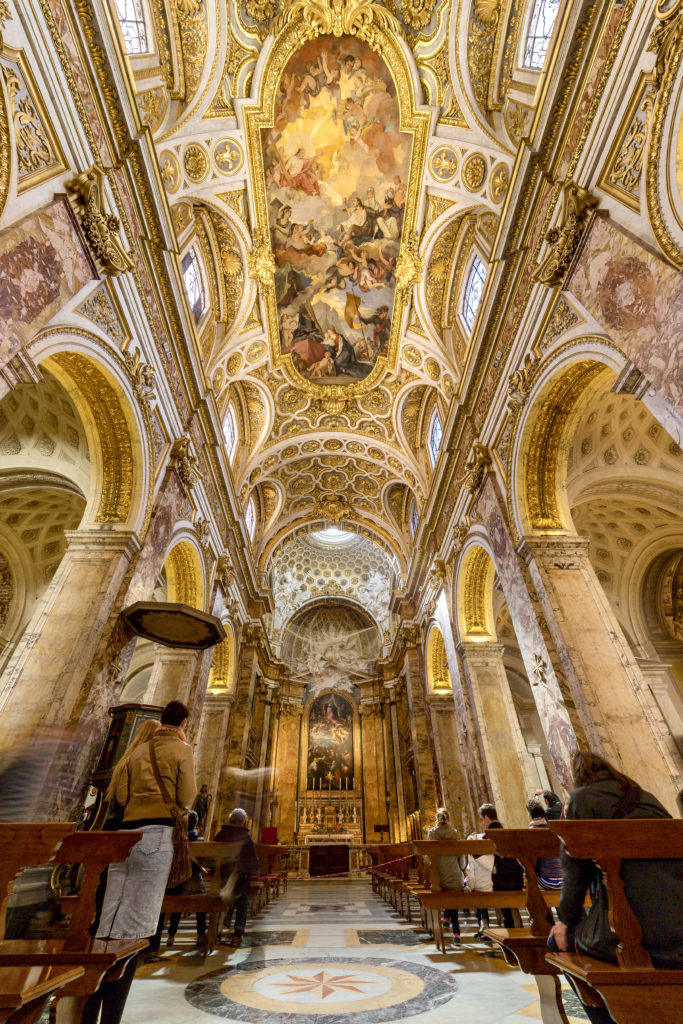
9. Church of St. Louis of the French
Time from Pantheon: 3 minutes
The next thing to see on your central Rome walking tour is the Church of San Luigi dei Francesi. It was built between 1523-98 and designed by Renaissance architect Giacomo della Porta.
The church is home to some world famous frescos and paintings. The chapel on the right has paintings by Domenicichini from 1616-17.
The real highlight of the church is to the left — the Contarelli Chapel. Thanks to his early patron Cardinal Francesco Maria Del Monte, Caravaggio won a major commission to paint the chapel.
The trio of paintings Caravaggio created launched a new artistic style, the Baroque era of painting. They made him an overnight sensation in Rome. A slew of stellar commissions followed.
Caravaggio painted the biblical scenes as if they were everyday images happening on the rough and rowdy streets of Rome.
His paintings were starkly realistic and flood lit. He used chiaroscuro (strong contrasts in light and dark to achieve volume) to dramatic effect.
If you love Caravaggio, you may be interested in this 3 hour art walking tour of his works n Rome.
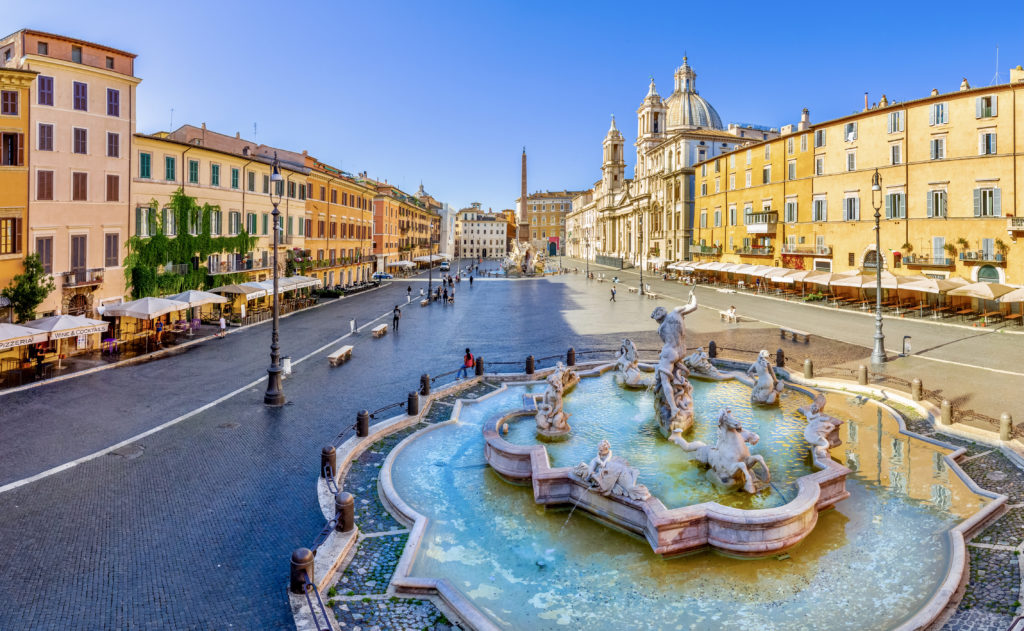
10. Piazza Navona
Time from Church of St. Louis of the French: 1 minute
Piazza Navona is sometimes called the Square of Fountains. The beautiful Baroque square is the very symbol of Rome.
Piazza Navona is a long rectangle flanked by ochre colored buildings. The square is always filled with tourists, artists, and street vendors. There’s also a Christmas market in the winter.
The square dates back to the time of Emperor Domitian in 86. He used it as a racetrack for chariot races and sporting matches. The buildings surrounded the piazza were once stadiums with screaming fans.
Beginning in 1652, Piazza Navona was turned into a lake in the summer. The drains of the fountains were closed and the square became flooded with water.
Aristocrats would decorate their coaches like traditional gondolas. Sometimes there were mock naval battles.
Today’s buildings date from the 16th century. The Doria Pamphilj family commissioned the Church of Sant’Agnese, the Bernini fountain, and restored the other fountains.
This area of Rome is incredibly special by night. You can book a 2 hour nighttime guided walking tour of Piazza Navona and the Trevi Fountain.
11. Church of Sant’Agnese
In Piazza Navona
The beautiful Church of Sant’Agnese in Piazza Navona was built by Borromini. He was an Italian architect who helped launch Roman Baroque architecture.
Borromini’s works combine classicism with passion. He used concave and convex forms to animate his buildings and eschewed over-decoration.
Sant-Agnese is one of his best works. Everyone goes to Piazza Navona and admires the striking concave facade. Most people don’t step inside the church. Do it, it’s free!
The church was commissioned by Pope Innocent X, of the Doria Pamphilj family. It stands on the site of a much older church dedicated to Saint Agnes. According to popular belief, she was martyred on this very spot.
The key element is the concave facade, a design of Borromini’s that revolutionized Baroque architecture.
It’s an ingenuous device. The facade accommodates a small space and allows the church to be seen from anywhere in Piazza Navona.
The facade is made of white travertine limestone with three portals. Pink and white marble covers the walls inside. The bright and simple interior is filled with Baroque statues. Beautiful frescos decorate the dome.
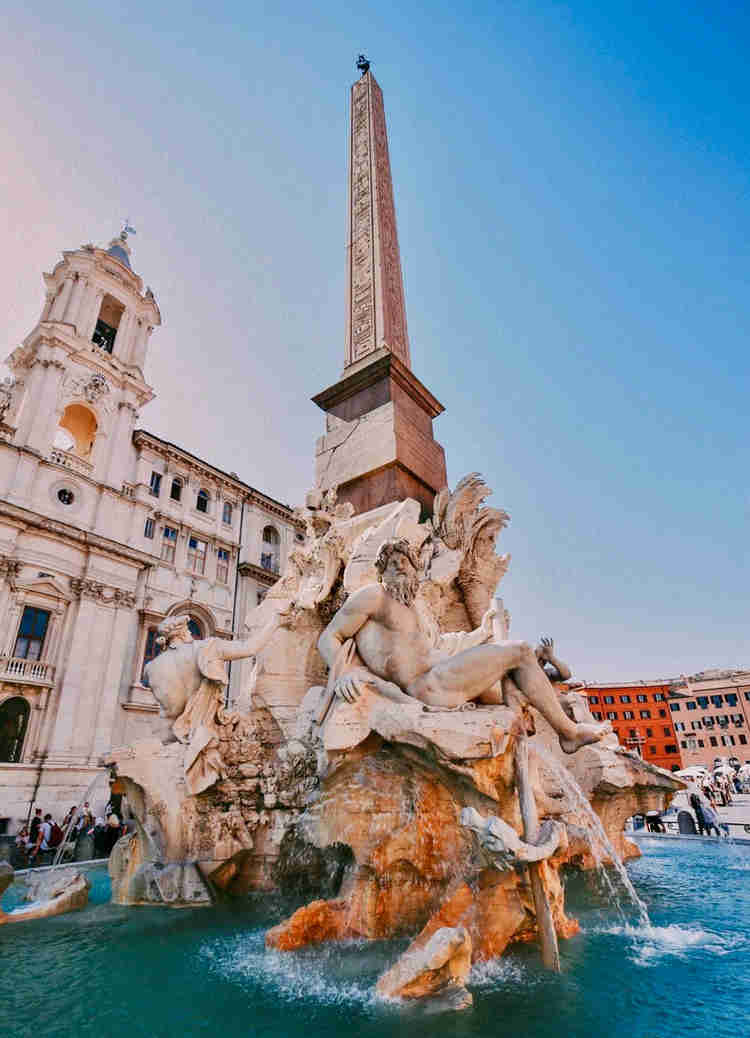
12. Bernini’s Four Rivers Fountain
In Piazza Navona
Piazza Navona is dominated by the beautiful Fountain of Four Rivers, Fontana dei Quattro Fiumi. It was designed by Gian Lorenzo Bernini. But Bernini almost didn’t get the commission.
Bernini had many rivals. Some had the ear of the new pope, Pope Innocent X, who succeeded Urban VIII. When Innocent X commissioned designs for the fountain from leading architects of Rome, he excluded Bernini.
One of Bernini’s allies, Nicole Ludovisi, persuaded Bernini to prepare a model of the fountain anyway. Ludovisi then displayed it in the Palazzo Doria Pamphilj, which the pope passed through every day.
As anticipated, when the pope saw the model, he was in ecstasy. He observed: “He who desires not to use Bernini’s designs, must take care not to see them.”
So Bernini won the contest for the fountain. In it, you see four muscular statues representing the gods. They represent the four great rivers of the world: the Danube, the Ganges, the Rio del Plato, and the Nile.
The fountain is festooned with palm trees and animals. A dove representing the Doria Pamphilj family sits atop the obelisk. Rising from the fountain is an Egyptian obelisk in honor of Domitian.
The fountain faces Borromini’s church. Bernini lost the commission for the church to Borromini. Legend holds that Bernini expressed his disdain for Borromini’s project through his fountain.
The River Nile appears to hide his face from the sight of the church. The Rio del Plata god has his hands raised, as if to protect himself in case Borromini’s church falls down.
It makes for a good story, but it’s just apocryphal. The fountain was completed before the church.
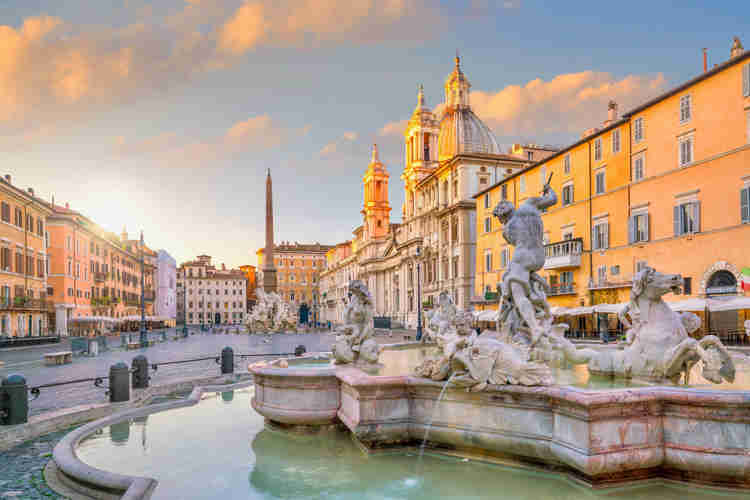
13. Fountain Of Neptune
The monumental Fountain of Neptune is at the northern end of Piazza Navona. It was created by the architect Giacomo della Porta in 1574.
The fountain shows the god of the sea battling an octopus. Sea monsters, cupids, and mermaids play with dolphins.
The statue of Neptune is the work of Antonio Della Bitta. It was was added in 1878 to make that fountain more symmetrical with the Moro Fountain in the south.
14. Church of Santa Maria della Pace
Time from Piazza Navona: 1 minute
In the center of Rome, just minutes from Piazza Navona, lies a secret church with a Baroque facade, Santa Maria della Pace. Inside, there’s art work that you wouldn’t expect for such a small and relatively unknown church. You’ll find works by Renaissance masters such as Raphael, Baldassarre Peruzzi, and Orazio Gentileschi.
There’s another Chigi Chapel in this church. It’s decorated with a fresco of the Sybils by Raphael. The fresco shows four sibyls, the oracles of ancient times, accompanied by attendant angels.
The sibyls bear a similarity to Michelangelo’s sibyls in the Sistine Chapel in the Vatican Museums. The beautiful Raphael fresco was just restored in 2020.
Annexed to the church is Bramante’s Cloister, an architectural gem. It was the first building completed by the great Renaissance architect, Donato Bramante. Once a tranquil internal cloister, the space is now used for special exhibitions.
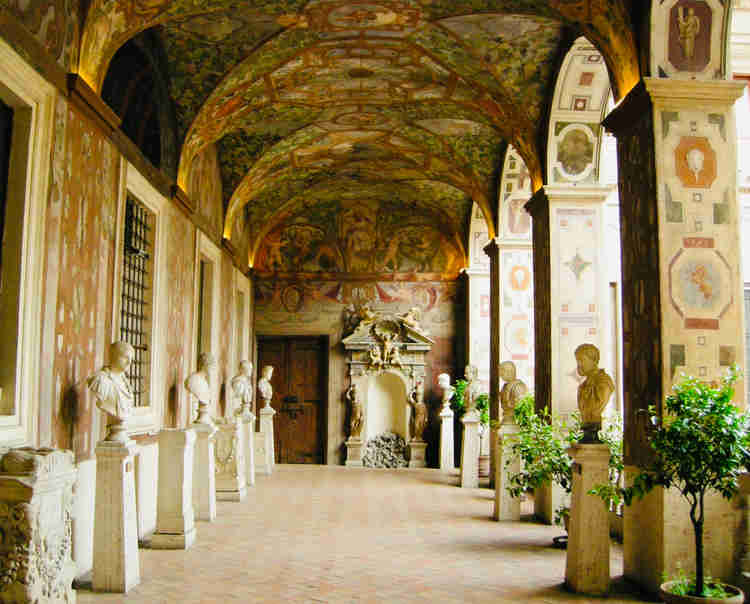
15. Palazzo Altemps
Time from Piazza Navona: 4 minutes
The 15th century Palazzo Altemps is a quiet oasis, only a few minutes away from the cacophony of the nearby Piazza Navona. It’s now part of the National Museum of Rome. It’s one of the best museums in Rome not on the standard Rome itinerary
Palazzo Altemps is definitely worth a visit if you admire ancient sculpture. The core of the collection are some superb ancient sculptures.
The collection was compiled by Ludovico Ludovisi, a nephew of Pope Gregory XV. The palace also has some lovey frescoed rooms, particularly the Sala delle Prospettive Dipinte.
The Palazzo Altempts isn’t a cluttered museum either. You’re given ample berth to view the sculptures. The major must see works include Apollo the Lyrist, the Ludovisi Athena, the Ludovisi Throne, the Grande Ludovisi Battle Sarcophagus, the Ludovisi Ares, and (the very bloody) Gallic Soldier and his Wife Committing Suicide.
The Grand Ludovisi Sarcophagus is especially impressive. Just look at the expressions on the Roman solider and the barbarians he’s about to slaughter.
The gory Gallic Soldier piece was discovered in 1621, along with the Dying Gaul masterpiece that’s in Rome’s Capitoline Museums. The sculpture was found during construction of the Villa Ludovisi, which was built on land that once belonged to Julius Caesar.
Click here to book a reserved entry ticket.
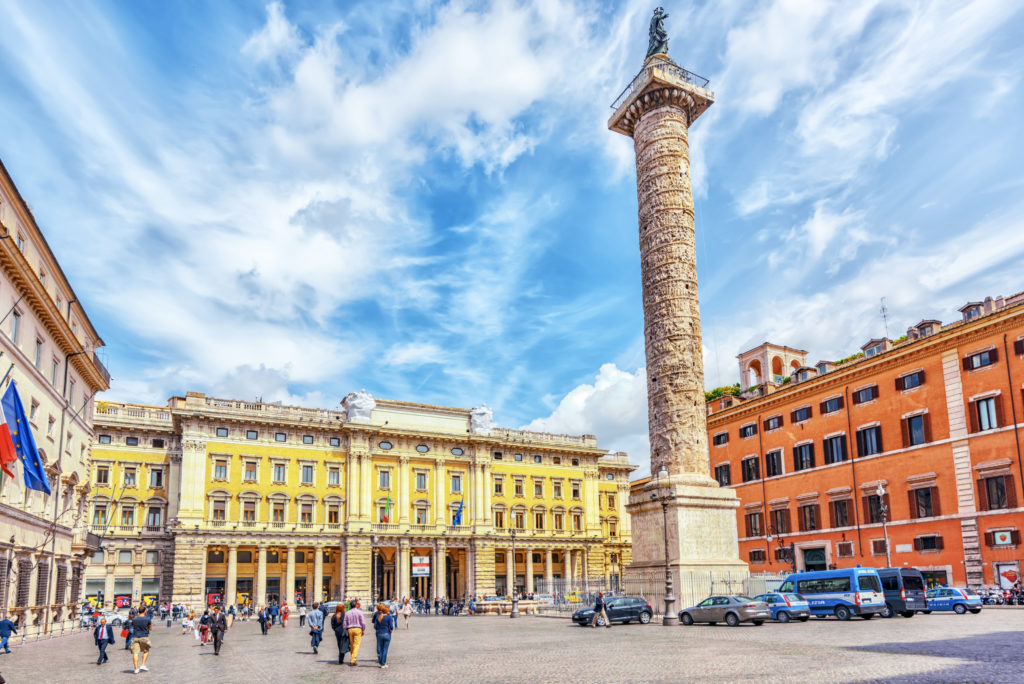
16. Piazza Colonna, Column of Marcus Aurelius
Time from Palazzo Altemps: 8 minutes
Now, it’s time to head east to the beautiful and stylish Piazza Colonna, one of Rome’s most famous squares.
In the center is the Column of Marcus Aurelius and Faustina. It was erected in 193 by the emperor’s son, Commodus, in memory of his father and mother. The piazza also holds the Palazzo Chigi, which is the official residence of Italy’s prime minister.
The column was inspired by Trajan’s Column, built in 113 CE. It’s carved in high relief with depictions of the emperor’s successful military campaigns against the Germanic tribes across the Danube in 172-75.
17. Trevi Fountain
Time from Piazza Colonna: 5 minutes
The next stop on your central Rome walking itinerary is the iconic Trevi Fountain. It’s an imposing Baroque monument designed by architect Nicola Salvi.
The design of the Trevi Fountain was chosen thanks to a competition. Italians loved a good competition, a tradition that began in the Renaissance.
In 1732, Pope Clement XII invited local artists to design an expansion for the existing (not so attractive) fountain at the end of the Acqua Vergine.
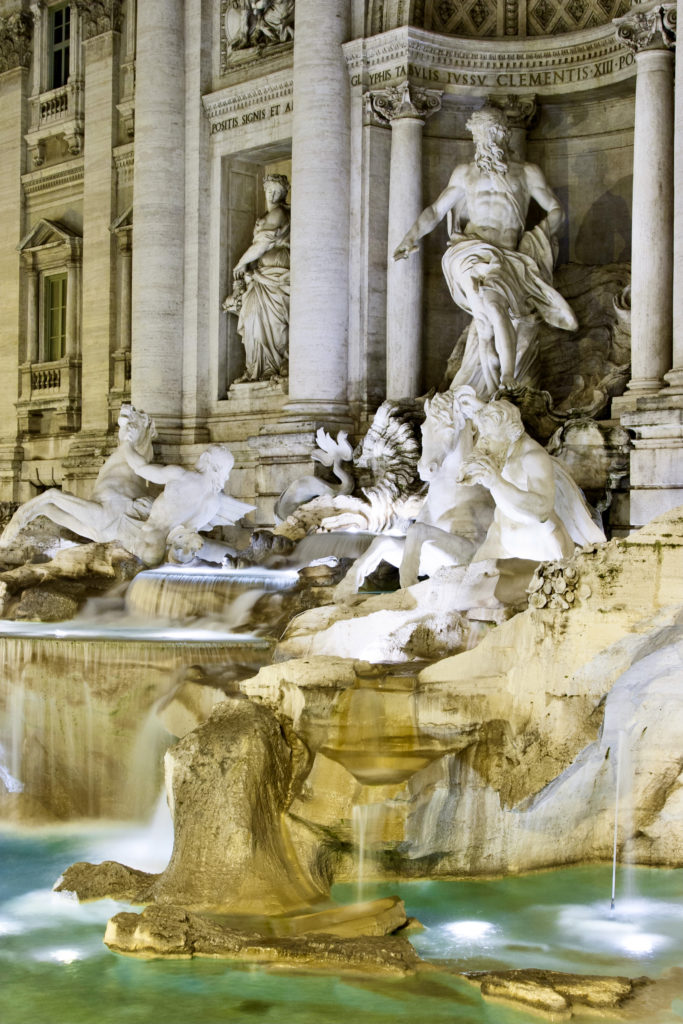
Salvi ultimately won the competition. But it was rumored that Galileo was the first pick. However, Galileo was from Florence, not Rome. Not a local, he was removed.
The fountain is 85 feet high and 65 feet wide, making it Rome’s largest fountain. In the center is the figure “Ocean.” Water pours from 24 spouts.
If you’re superstitious, toss a coin over your shoulder to ensure your return to Rome. On average, 3000 euros are collected each day and donated to charity.
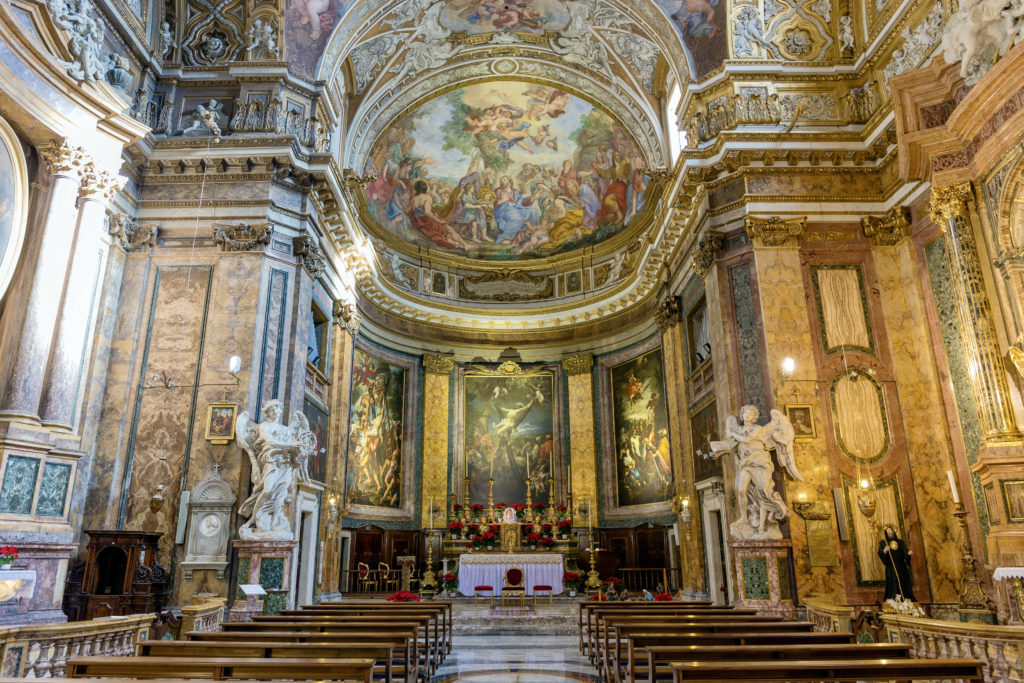
18. Sant’Andrea delle Fratte
Time from Trevi Fountain: 5 minutes
Just north of the Trevi Fountain is the Church of Sant’Andrea delle Fratte, a must see while walking through central Rome. This 17th century basilica is dedicated to Saint Andrew.
This is where you come to admire two of Bernini’s original angels, copies of which now grace the Ponte Sant’Angelo. It’s just off the Via Veneto, not far from Piazza Barberini.
The angels are in the sides of the presbytery, which is a part of the church reserved for clergy. You can see the Angel with the Crown of Thorns and the Angel with the Scroll.
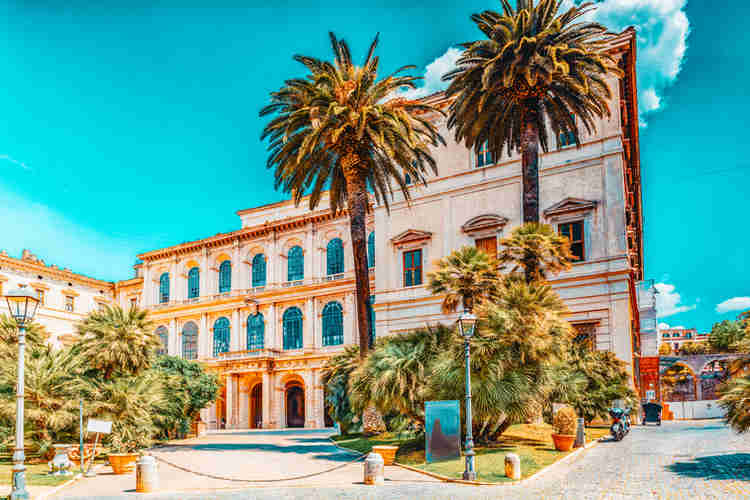
19. Palazzo Barberini
Time from Sant’Andrea delle Fratte: 9 minutes
As an option, if you want, you can peel off to the east to visit the Piazza Barberini and Palazzo Barberini before heading to the Spanish Steps.
Piazza Barberini is a large piazza situated on the Quirinal Hill. It was created in the 16th century. The square was named after the Palazzo Barberini.
The palazzo is a luxurious 17th century Baroque palace-museum. It’s fully renovated and unapologetically grand. The palace is a magnificent backdrop for the Barberini’s stunning art collection, which includes masterpieces by Raphael and Caravaggio.
Click here for a skip the line entrance ticket. Click here for a 2 hour guided tour of the museum or here for a private tour.
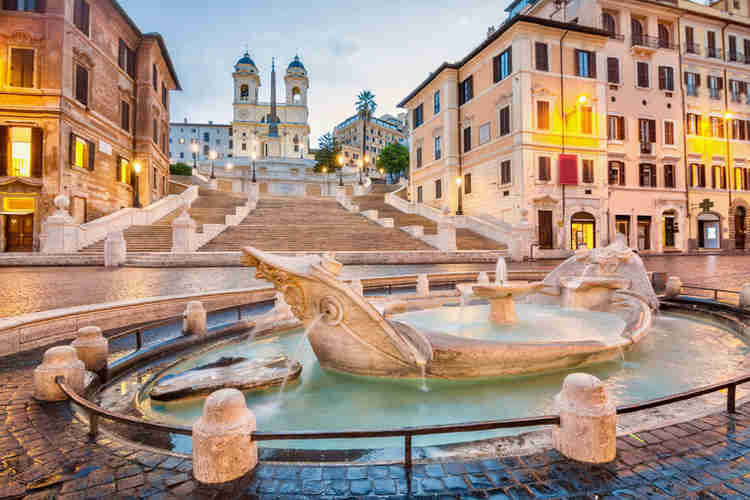
20. Spanish Steps
Time from Palazzo Barberini: 9 minutes
If you skipped Palazzo Barberini, the time from Sant Andrea della Fratte: 3 minutes
The Spanish Steps are a beautiful set of steps and one of central Rome’s most recognizable landmarks. They climb a steep slope between the Piazza di Spagna at the base and Piazza Trinità dei Monti, dominated by the Trinità dei Monti church at the top.
As of 2019, you can no longer sit on the Spanish Steps. It’s classified as a national monument.
A new law cracked down on “bad behavior” in Rome. If you’re caught sitting on the Spanish Steps, you risk paying a € 400 fine.
And, by the way, the Spanish Steps aren’t Spanish. They’re just named after the Spanish Embassy at the top of them.
21. Piazza del Popolo
Time from the Spanish Steps: 9 minutes
After leaving the Spanish steps, head west down Via Condotti. Turn right at Via del Corso to head north to the Piazza del Popolo.
Both streets offer plenty of upscale shopping. Piazza del Popolo is where the Via del Corso, Via del Babuino, and Via di Ripetta converge.
The main points of interest in the piazza are the Egyptian obelisk, three churches, and two fountains. The fountains are the Fountain of Neptune and the Fountain of Roma.
Be sure to climb up the steps to the Pincio Terrace. There, you’ll have fine views over Rome, especially at sunset.
22. Church of Santa Maria del Popolo
In Piazza del Popolo
While you’re in the Piazza del Popolo, be sure to visit Santa Maria del Popolo. It’s a beautiful basilica on the northern end of piazza. Like so many of Rome’s churches, the Popolo has an unassuming facade, but inside houses magnificent artistic treasures.
The church has a classic basilica plan — a Latin cross footprint with a nave and two side aisles. There are four chapels in each aisle and a transept with a central dome.
In the 17th century, Pope Alexander VII had Bernini give the church’s nave a Baroque makeover. Bernini designed a rather gaudy main altar.
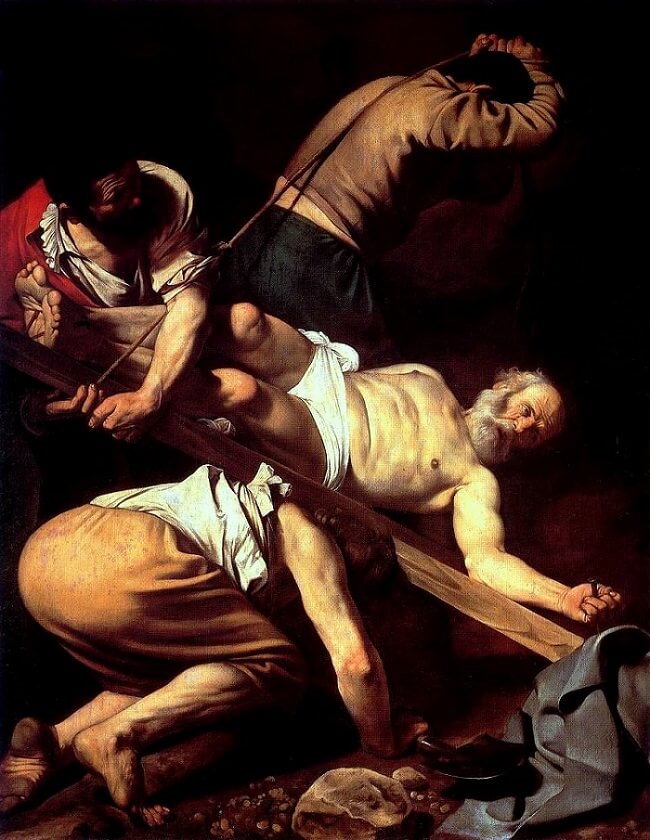
You can find works by the greatest Renaissance and Baroque artists of the day — Caravaggio, Raphael, Bernini, Pinturicchio, and Carracci. The most famous works can be found in the Chigi Chapel and the Cerasi Chapel.
The stunning Chigi Chapel not only features sculptures by Bernini, but has paintings by Caravaggio and mosaics designed by Raphael. The floor mosaic is Bernini’s Winged Death with the Chigi coat of arms.
Sebastian del Piombo created the altarpiece painting between the Bernini sculptures. Del Piombo, a favorite of Michelangelo, used a Michelangelo cartoon to paint the Nativity of the Virgin.
I hope you’ve enjoy my guide to central Rome. You may enjoy these other Rome travel guides and resources.
- 3 day itinerary for Rome
- 4 day itinerary for Rome
- 5 day itinerary for Rome
- Hidden gems in Rome
- Best museums in Rome
- Archaeological sites in Rome
- Guide to the Borghese Gallery
- Rome’s secret palace museums
- Guide to the Capitoline Museums
Pin it for later.

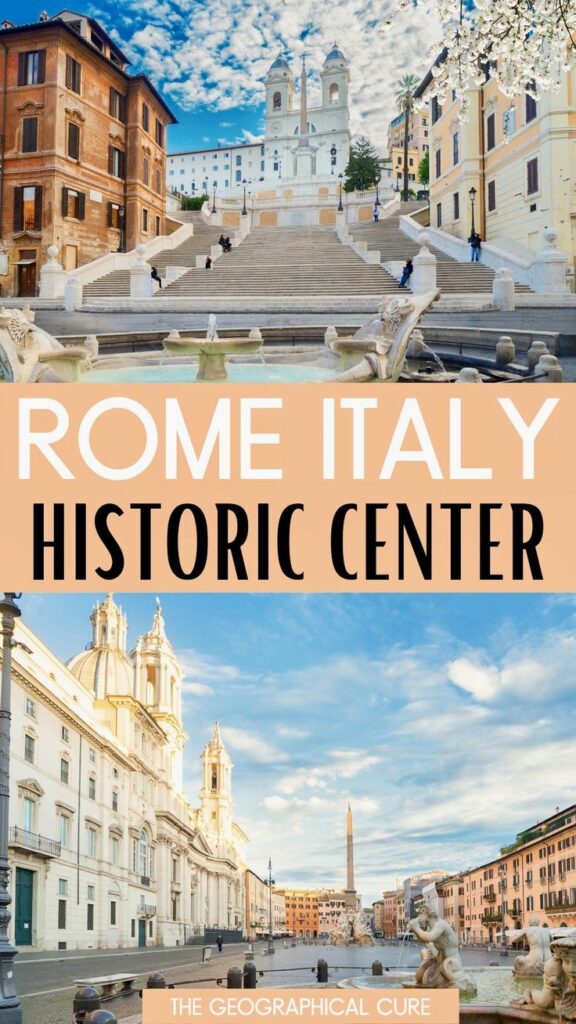
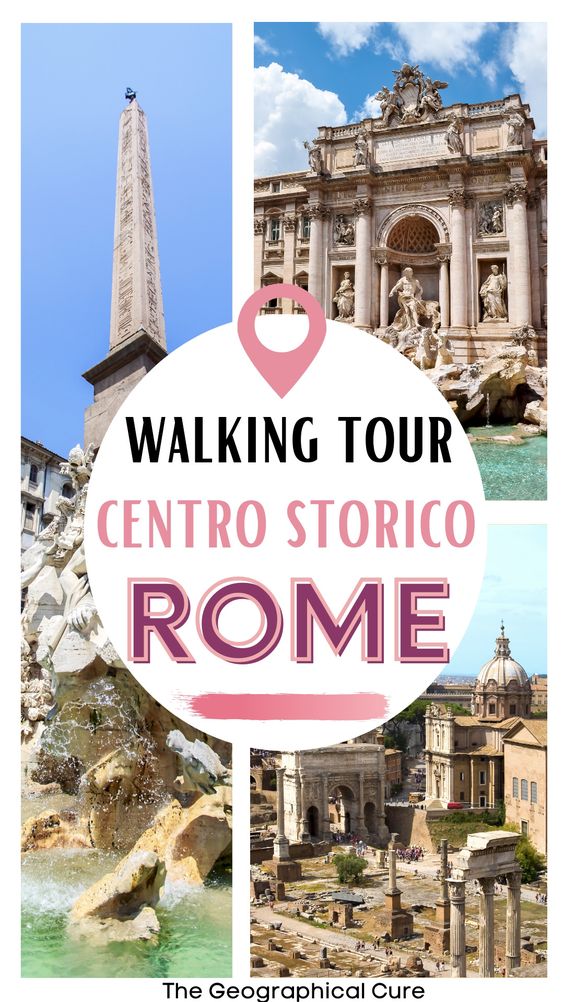
For my particular interests as a first-time side trip while visiting Florence, there’s absolutely no need to Google any farther than Leslie’s spectacular post. Completely spot on for me and I don’t have to spend any more time planning my visit. It’s all here. I’m gonna look pretty silly walking her route with my face in my iPad but who cares. Thank you Leslie, you’re one of the brightest stars in cyberspace.
Wow! Thank you so much Dallas! Enjoy the stroll. It’s one of the best in Europe!
As usual a great read and wonderful pictures. I want to be there